A Review of Ice Cloud Optical Property Models for Passive Satellite Remote Sensing
Abstract
:1. Introduction
2. Theoretical Basis for the Optical Properties of Ice Clouds
3. Ice Cloud Optical Models for Remote Sensing Applications
3.1. Ice Particle Shape and Orientation
3.2. Bulk Optical Properties for Passive Remote Sensing Applications
3.3. Spectral Consistency of Bulk Ice Particle Models
4. Summary
Author Contributions
Funding
Acknowledgments
Conflicts of Interest
References
- Liou, K.N. Influence of cirrus clouds on weather and climate processes—A global perspective. Mon. Weather Rev. 1986, 114, 1167–1199. [Google Scholar] [CrossRef]
- Baran, A.J. A review of the light scattering properties of cirrus. J. Quant. Spectrosc. Radiat. Transf. 2009, 110, 1239–1260. [Google Scholar] [CrossRef]
- Baran, A.J. From the single-scattering properties of ice crystals to climate prediction: A way forward. Atmos. Res. 2012, 112, 45–69. [Google Scholar] [CrossRef]
- Liou, K.N.; Yang, P. Light Scattering by Ice Crystals: Fundamentals and Applications, 1st ed.; Cambridge University Press: Cambridge, UK, 2017. [Google Scholar]
- Zhang, M.; Lin, W.Y.; Klein, S.A.; Bacmeister, J.T.; Bony, S.; Cederwall, R.T.; Del Genio, A.D.; Hack, J.J.; Loeb, N.G.; Lohmann, U.; et al. Comparing clouds and their seasonal variations in 10 atmospheric general circulation models with satellite measurements. J. Geophys. Res. 2005, 110, D15S02. [Google Scholar] [CrossRef]
- Ahrens, C.D.; Henson, R. Meteorology Today: An Introduction to Weather, 12nd ed.; Cengage Learning: Boston, MA, USA, 2018. [Google Scholar]
- Liou, K.N. Radiation and Cloud Processes in the Atmosphere: Theory, Observation, and Modeling; Description and Reviews; Oxford University Press: New York, NY, USA, 1992; 487p. [Google Scholar]
- Wylie, D.P.; Menzel, W.P. Eight years of high cloud statistics using HIRS. J. Clim. 1999, 12, 170–184. [Google Scholar] [CrossRef]
- Rossow, W.B.; Schiffer, R.A. ISCCP cloud data products. Bull. Am. Meteorol. Soc. 1991, 72, 2–20. [Google Scholar] [CrossRef]
- Stubenrauch, C.J.; Rossow, W.B.; Kinne, S.; Ackerman, S.; Cesana, G.; Chepfer, H.; Di Girolamo, L.; Getzewich, B.; Guignard, A.; Heidinger, A.; et al. Assessment of global cloud datasets from satellites: Project and database initiated by the GEWEX radiation panel. Bull. Am. Meteorol. Soc. 2013, 94, 1031–1049. [Google Scholar] [CrossRef]
- Massie, S.; Gettleman, A.; Randel, W.; Baumgardner, D. The distribution of tropical cirrus in relation to convection. J. Geophys. Res. 2002, 107. [Google Scholar] [CrossRef]
- Waliser, D.E.; Li, J.-L.F.; Woods, C.P.; Austin, R.T.; Bacmeister, J.; Chern, J.; Del Genio, A.; Jiang, J.H.; Kuang, Z.; Meng, H.; et al. Cloud ice: A climate model challenge with signs and expectations of progress. J. Geophys. Res. 2009, 114. [Google Scholar] [CrossRef]
- Elsaesser, G.S.; Del Genio, A.D.; Jiang, J.; van Lier-Walqui, M. An improved convective ice parameterization for the NASA GISS Global Climate Model and impacts on cloud ice simulation. J. Clim. 2016, 30, 317–336. [Google Scholar] [CrossRef]
- Deng, M.; Mace, G.G.; Wang, Z.; Lawson, R.P. Evaluation of Several A-Train Ice Cloud Retrieval Products with In Situ Measurements Collected during the SPARTICUS Campaign. J. Appl. Meteorol. Climatol. 2013, 52, 1014–1030. [Google Scholar] [CrossRef]
- Deng, M.; Mace, G.G.; Wang, Z.; Berry, E. CloudSat 2C-IE product update with a new Ze parameterization in lidar-only region. J. Geophys. Res. Atmos. 2015, 120, 12198–12208. [Google Scholar] [CrossRef] [PubMed]
- Heidinger, A.K.; Foster, M.J.; Walther, A.; Zhao, X. The pathfinder atmospheres-extended AVHRR climate dataset. Bull. Amer. Meteorol. Soc. 2014, 95, 909–922. [Google Scholar] [CrossRef]
- King, M.D.; Menzel, W.P.; Kaufman, Y.J.; Tanre, D.; Gao, B.C.; Platnick, S.; Ackerman, S.A.; Remer, L.A.; Pincus, R.; Hubanks, P.A. Cloud and aerosol properties, precipitable water, and profiles of temperature and water vapor from MODIS. IEEE Trans. Geosci. Remote Sens. 2003, 41, 442–458. [Google Scholar] [CrossRef] [Green Version]
- Platnick, S.; King, M.D.; Ackerman, S.A.; Menzel, W.P.; Baum, B.A.; Riedi, J.C.; Frey, R.A. The MODIS cloud products: Algorithms and examples from Terra. IEEE Trans. Geosci. Remote Sens. 2003, 41, 459–473. [Google Scholar] [CrossRef]
- Lee, T.E.; Miller, S.D.; Turk, F.J.; Schueler, C.; Julian, R.; Deyo, S.; Dills, P.; Wang, S. The NPOESS VIIRS day/night visible sensor. Bull. Am. Meteorol. Soc. 2006, 87, 191–199. [Google Scholar] [CrossRef]
- Skofronick-Jackson, G.; Petersen, W.A.; Berg, W.; Kidd, C.; Stocker, E.F.; Kirschbaum, D.B.; Kakar, R.; Braun, S.A.; Huffman, G.J.; Iguchi, T.; et al. The Global Precipitation Measurement (GPM) Mission for Science and Society. Bull. Am. Meteorol. Soc. 2017, 98, 1657–1672. [Google Scholar] [CrossRef]
- Hou, A.Y.; Kakar, R.K.; Neeck, S.; Azarbarzin, A.; Kummerow, C.D.; Kojima, M.; Oki, R.; Nakamura, K.; Iguchi, T. The Global Precipitation Measurement Mission. Bull. Am. Meteorol. Soc. 2014, 95, 701–722. [Google Scholar] [CrossRef] [Green Version]
- Karlsson, K.-G.; Riihela, A.; Muller, R.; Meirink, J.F.; Sedlar, J.; Stengel, M.; Lockhoff, M.; Trentmann, J.; Kaspar, F.; Hollmann, R.; et al. CLARA-A1: A cloud, albedo, and radiation dataset from 28 yr of global AVHRR data. Atmos. Chem. Phys. 2013, 13, 5351–5367. [Google Scholar] [CrossRef]
- Walther, A.; Heidinger, A.K. Implementation of the daytime cloud optical and microphysical properties algorithm (DCOMP) in PATMOS-x. J. Appl. Meteorol. Climatol. 2012, 51, 1371–1390. [Google Scholar] [CrossRef]
- Platnick, S.; Meyer, K.G.; King, M.D.; Wind, G.; Amarasinghe, N.; Marchant, B.; Arnold, G.T.; Zhang, Z.; Hubanks, P.A.; Holz, R.E.; et al. The MODIS cloud optical and microphysical products: Collection 6 updates and examples from Terra and Aqua. IEEE Trans. Geosci. Remote Sens. 2017, 55, 502–525. [Google Scholar] [CrossRef] [PubMed]
- Greenwald, T.J.; Stephens, G.L.; Vonder Haar, T.H.; Jackson, D.L. A physical retrieval of cloud liquid water over the global oceans using Special Sensor Microwave/Imager (SSM/I) observations. J. Geophys. Res. 1993, 98, 18471–18488. [Google Scholar] [CrossRef]
- Gong, J.; Wu, D.L. Microphysical properties of frozen particles inferred from Global Precipitation Measurement (GPM) Microwave Imager (GMI) polarimetric measurements. Atmos. Chem. Phys. 2017, 17, 2741–2757. [Google Scholar] [CrossRef] [Green Version]
- Baran, A.J.; Ishimoto, H.; Sourdeval, O.; Hesse, E.; Harlow, C. The applicability of physical optics in the millimeter and sub-millimetre spectral region. Part II: Application to a three-component model of ice cloud and its evaluation against the bulk single-scattering properties of various other aggregate models. J. Quant. Spectrosc. Radiat. Transf. 2018, 206, 83–100. [Google Scholar] [CrossRef]
- Deschamps, P.Y.; Breon, F.M.; Leroy, M.; Podaire, A.; Bricaud, A.; Buriez, J.C.; Seze, G. The POLDER mission - Instrument characteristics and scientific objectives. IEEE Trans. Geosci. Remote Sens. 1994, 32, 598–615. [Google Scholar] [CrossRef]
- Winker, D.M.; Pelon, J.; McCormick, M.P. The CALIPSO mission: Spaceborne lidar for observation of aerosols and clouds. Proc. SPIE 2003, 4893. [Google Scholar] [CrossRef]
- Heidinger, A.; Pavolonis, M.; Holz, R.; Baum, B.A.; Berthier, S. Using CALIPSO to explore the sensitivity to cirrus height in the infrared observations from NPOESS/VIIRS and GOES-R/ABI. J. Geophys. Res.-Atmos. 2010, 115, D00H20. [Google Scholar] [CrossRef]
- Avery, M.; Winker, D.; Heymsfield, A.; Vaughan, M.; Young, S.; Hu, Y.; Trepte, C. Cloud ice water content retrieved from the CALIOP space-based lidar. Geophys. Res. Lett. 2012, 39, L05808. [Google Scholar] [CrossRef]
- Delanoë, J.; Hogan, R.J. A variational scheme for retrieving ice cloud properties from combined radar, lidar, and infrared radiometer. J. Geophys. Res.-Atmos. 2008, 113, D07204. [Google Scholar] [CrossRef]
- Delanoë, J.; Hogan, R.J. Combined CloudSat-CALIPSO-MODIS retrievals of the properties of ice clouds. J. Geophys. Res.-Atmos. 2010, 115, D00H29. [Google Scholar] [CrossRef]
- Matrosov, S.Y. The use of CloudSat data to evaluate retrievals of total ice content in precipitating cloud systems from ground-based operational radar measurements. J. Appl. Meteorol. Climatol. 2015, 54, 1663–1674. [Google Scholar] [CrossRef]
- Kahn, B.H.; Irion, F.W.; Dang, V.T.; Manning, E.M.; Nasiri, S.L.; Naud, C.M.; Blaisdell, J.M.; SWchreier, M.M.; Yue, Q.; Bowman, K.W.; et al. The Atmospheric Infrared Sounder version 6 cloud products. Atmos. Chem. Phys. 2014, 14, 399–426. [Google Scholar] [CrossRef] [Green Version]
- Han, Y.; Revercomb, H.; Cromp, M.; Gu, D.; Johnson, D.; Mooney, D.; Scott, D.; Strow, L.; Bingham, G.; Borg, L.; et al. Suomi NPP CrIS measurements, sensor data record algorithm, calibration and validation activities, and record data quality. J. Geophys. Res. Atmos. 2013, 118. [Google Scholar] [CrossRef]
- Klaes, D.; Montagner, F.; Larigauderie, C. Metop-B, the second satellite of the EUMETSAT polar system, in orbit. Proc. SPIE 2013, 8866, 886613. [Google Scholar]
- Hamann, U.; Walther, A.; Baum, B.A.; Bennartz, R.; Bugliaro, L.; Derrien, M.; Francis, P.N.; Heidinger, A.; Joro, S.; Kniffka, A.; et al. Remote sensing of cloud top pressure/height from SEVIRI: Analysis of ten current retrieval algorithms. Atmos. Meas. Tech. 2014, 7, 2839–2867. [Google Scholar] [CrossRef]
- Roebeling, R.A.; Feijt, A.J.; Stammes, P. Cloud property retrievals for climate monitoring: Implications of differences between SEVIRI on METEOSAT-8 and AVHRR on NOAA-17. J. Geophys. Res. 2006, 111, D20210. [Google Scholar] [CrossRef]
- Iwabuchi, H.; Putri, N.S.; Saito, M.; Tokoro, Y.; Sekiguchi, M.; Yang, P.; Baum, B.A. Cloud property retrieval from multiband infrared measurements by Himawari-8. J. Meteorol. Soc. Jpn. 2018, 96B, 27–42. [Google Scholar] [CrossRef]
- Schmit, T.J.; Griffith, P.; Gunshor, M.M.; Daniels, J.M.; Goodman, S.J.; Lebair, W.J. A closer look at the ABI on the GOES-R series. Bull. Am. Meteorol. Soc. 2017, 98, 681–698. [Google Scholar] [CrossRef]
- Nakajima, T.; King, M.D. Determination of the optical-thickness and effective particle radius of clouds from reflected solar-radiation measurements. Part I: Theory. J. Atmos. Sci. 1990, 47, 1878–1893. [Google Scholar] [CrossRef]
- Twomey, S.; Seton, K.J. Inferences of gross microphysical properties of clouds from spectral reflectance measurements. J. Atmos. Sci. 1980, 37, 1065–1069. [Google Scholar] [CrossRef]
- Twomey, S.; Cocks, T. Spectral reflectance of clouds in the near-infrared: Comparison of measurements and calculations. J. Meteorol. Soc. Jpn. 1982, 60, 583–592. [Google Scholar] [CrossRef]
- Twomey, S.; Cocks, T. Remote sensing of cloud parameters from spectral reflectance in the near-infrared. Beitr. Phys. Atmos. 1989, 62, 172–179. [Google Scholar]
- Curran, R.J.; Wu, M.L.C. Skylab near-infrared observations of clouds indicating supercooled liquid water droplets. J. Atmos. Sci. 1982, 39, 635–647. [Google Scholar] [CrossRef]
- Inoue, T. On the temperature and effective emissivity determination of semi-transparent cirrus clouds by bi-spectral measurements in the 10 μm window region. J. Meteorol. Soc. Jpn. 1985, 63, 88–99. [Google Scholar] [CrossRef]
- Chiriaco, M.; Chepfer, H.; Noel, V.; Delaval, A.; Haeffelin, M.; Dubuisson, P.; Yang, P. Improving retrievals of cirrus cloud particle size coupling lidar and three-channel radiometric techniques. Mon. Weather. Rev. 2004, 32, 1684–1700. [Google Scholar] [CrossRef]
- Garnier, A.; Pelon, J.; Dubuisson, P.; Yang, P.; Faivre, M.; Chomette, O.; Pascal, N.; Lucker, P.; Murray, T. Retrieval of cloud properties using CALIPSO imaging infrared radiometer. Part II: Effective diameter and ice water path. J. Appl. Meteorol. Clim. 2013, 52, 2582–2599. [Google Scholar] [CrossRef]
- Wang, C.; Platnick, S.; Zhang, Z.; Meyer, K.; Yang, P. Retrieval of ice cloud properties using an optimal estimation algorithm and modis infrared observations: 1. Forward model, error analysis, and information content. J. Geophys. Res. Atmos. 2016, 121, 5809–5826. [Google Scholar] [CrossRef] [PubMed]
- Wang, C.; Platnick, S.; Zhang, Z.; Meyer, K.; Wind, G.; Yang, P. Retrieval of ice cloud properties using an optimal estimation algorithm and MODIS infrared observations: 2. Retrieval evaluation. J. Geophys. Res. Atmos. 2016, 121, 5827–5845. [Google Scholar] [CrossRef] [Green Version]
- Wielicki, B.A.; Barkstrom, B.R.; Baum, B.A.; Charlock, T.P.; Green, R.N.; Kratz, D.P.; Lee, R.B., III; Minnis, P.; Smith, G.L.; Wong, T.; et al. Clouds and the Earth’s Radiant Energy System (CERES): Algorithm overview. IEEE Trans. Geosci. Remote Sens. 1998, 36, 1127–1141. [Google Scholar] [CrossRef]
- Bessho, K.; Date, K.; Hayashi, M.; Ikeda, A.; Imai, T.; Inoue, H.; Kumagai, Y.; Miyakawa, T.; Murata, H.; Ohno, T.; et al. An introduction to Himawari-8/9—Japan’s new generation of geostationary meteorology satellites. J. Meteorol. Soc. Jpn. 2016, 94, 151–183. [Google Scholar] [CrossRef]
- Chandrasekhar, S. Radiative Transfer; Oxford University Press: London, UK, 1960. [Google Scholar]
- Liou, K.N. An Introduction to Atmospheric Radiation; International Geophysics Series #26; Academic Press: New York, NY, USA, 1980; 392p. [Google Scholar]
- Liou, K.N. An Introduction to Atmospheric Radiation, 2nd ed.; International Geophysics Series; Academic Press: San Diego, CA, USA, 2002; Volume 84, 583p. [Google Scholar]
- Hovenier, J.W.; van der Mee, C.; Domke, H. Transfer of Polarized Light in Planetary Atmospheres; Kluwer Academic Publishers: Dordrecht, The Netherlands, 2004; 258p. [Google Scholar]
- Van de Hulst, H.C. Light Scattering by Small Particles; Wiley: Hoboken, NJ, USA, 1957; 470p. [Google Scholar]
- Mishchenko, M.I.; Travis, L.D.; Lacis, A.A. Scattering, Absorption and Emission of Light by Small Particles; Cambridge University Press: Cambridge, UK, 2002; 445p. [Google Scholar]
- Mishchenko, M.I.; Travis, L.D.; Lacis, A.A. Multiple Scattering of Light by Particles: Radiative Transfer and Coherent Backscattering; Cambridge University Press: Cambridge, UK, 2006. [Google Scholar]
- Mishchenko, M.I.; Yurkin, M.A. On the concept of random orientation in far-field electromagnetic scattering by nonspherical particles. Opt. Lett. 2017, 42, 494–497. [Google Scholar] [CrossRef] [PubMed]
- Houghton, J.T.; Hunt, G.E. Detection of ice clouds from remote measurements of their emission in far infra-red. Q. J. R. Meteorol. Soc. 1971, 97, 1–17. [Google Scholar] [CrossRef]
- Bailey, M.; Hallett, J. Nucleation effects on the habit of vapour grown ice crystals from −18 to −42 °C. Q. J. R. Meteorol. Soc. 2002, 128, 1461–1483. [Google Scholar]
- Bailey, M.; Hallett, J. Growth rates and habits of ice crystals between −20 °C and −70 °C. J. Atmos. Sci. 2004, 61, 514–544. [Google Scholar] [CrossRef]
- Heymsfield, A.J.; Lewis, S.; Bansemer, A.; Iaquinta, J.; Miloshevich, L.M.; Kajikawa, M.; Twohy, C.; Poellot, M.R. A general approach for deriving the properties of cirrus and stratiform ice cloud particles. J. Atmos. Sci. 2002, 59, 3–29. [Google Scholar] [CrossRef]
- Korolev, A.; Isaac, G.A.; Hallett, J. Ice particle habits in Arctic clouds. Geophys. Res. Lett. 1999, 26, 1299–1302. [Google Scholar] [CrossRef] [Green Version]
- Korolev, A.; Isaac, G.A.; Hallett, J. Ice particle habits in stratiform clouds. Q. J. R. Meteorol. Soc. 2000, 126, 2873–2902. [Google Scholar] [CrossRef]
- Asano, S.; Yamamoto, G. Light-scattering by a spheroidal particle. Appl. Opt. 1975, 14, 29–49. [Google Scholar] [CrossRef]
- Yee, K.S. Numerical solution of initial boundary value problems involving maxwells equations in isotropic media. IEEE Trans. Antennas Propag. 1966, AP14, 302–307. [Google Scholar]
- Tafolve, A.; Hagness, S.C. Computational Electromagnetics: The Finite-Difference Time-Domain Method; Artech House, Inc.: Norwood, MA, USA, 2000. [Google Scholar]
- Yang, P.; Liou, K.N. Finite-difference time domain method for light scattering by small ice crystals in three-dimensional space. J. Opt. Soc. Am. 1996, 13, 2072–2085. [Google Scholar] [CrossRef]
- Purcell, E.M.; Pennypacker, C.R. Scattering and absorption of light by nonspherical dielectric grains. Astrophys. J. 1973, 186, 705–714. [Google Scholar] [CrossRef]
- Draine, B.T.; Flatau, P.J. Discrete dipole approximation for scattering calculations. J. Opt. Soc. Am. A 1994, 11, 1491–1499. [Google Scholar] [CrossRef]
- Yurkin, M.A.; Hoekstra, A.G. The discrete dipole approximation: An overview and recent developments. J. Quant. Spectrosc. Radiat. Transf. 2007, 106, 558–589. [Google Scholar] [CrossRef] [Green Version]
- Waterman, P.C. Matrix formulation of electromagnetic scattering. Proc. IEEE 1965, 53, 805–812. [Google Scholar] [CrossRef]
- Waterman, P.C. Matrix methods in potential theory and electromagnetic scattering. J. Appl. Phys. 1979, 50, 4550–4560. [Google Scholar] [CrossRef]
- Mishchenko, M.I.; Travis, L.D. Light scattering by polydispersions of randomly oriented spheroids with sizes comparable to wavelengths of observation. Appl. Opt. 1994, 33, 7206–7225. [Google Scholar] [CrossRef] [PubMed]
- Cai, Q.; Liou, K.N. Polarized-light scattering by hexagonal ice crystals—Theory. Appl. Opt. 1982, 21, 3569–3580. [Google Scholar] [CrossRef]
- Takano, Y.; Liou, K.N. Solar radiative transfer in cirrus clouds. Part I: Single-scattering and optical properties of hexagonal ice crystals. J. Atmos. Sci. 1989, 46, 3–19. [Google Scholar] [CrossRef]
- Macke, A. Scattering of light by polyhedral ice crystals. Appl. Opt. 1993, 32, 2780–2788. [Google Scholar] [CrossRef]
- Macke, A.; Mueller, J.; Raschke, E. Single scattering properties of atmospheric ice crystals. J. Atmos. Sci. 1996, 53, 2813–2825. [Google Scholar] [CrossRef]
- Muinonen, K.; Nousiainen, T.; Fast, P.; Lumme, K.; Peltoniemi, J.I. Light scattering by gaussian random particles: Ray optics approximation. J. Quant. Spectrosc. Radiat. Transf. 1996, 55, 577–601. [Google Scholar] [CrossRef]
- Yang, P.; Liou, K.N. Geometric-optics-integral-equation method for light scattering by nonspherical ice crystals. Appl. Opt. 1996, 35, 6568–6584. [Google Scholar] [CrossRef] [PubMed]
- Yang, P.; Liou, K.N. Light scattering by hexagonal ice crystals: Solution by a ray-by-ray integration algorithm. J. Opt. Soc. Am. A Opt. Image Sci. 1997, 14, 2278–2288. [Google Scholar] [CrossRef]
- Yang, P.; Liou, K.N. Single-scattering properties of complex ice crystals in terrestrial atmosphere. Contrib. Atmos. Phys. 1998, 71, 223–248. [Google Scholar]
- Mishchenko, M.I.; Hovenier, J.W.; Travis, L.D. Light Scattering by Nonspherical Particles: Theory, Measurements, and Applications; Academic Press: Cambridge, MA, USA, 2000; 690p. [Google Scholar]
- Bi, L.; Yang, P.; Kattawar, G.W.; Mishchenko, M.I. Efficient implementation of the invariant imbedding T-matrix method and the separation of variables method applied to large nonspherical inhomogenous particles. J. Quant. Spectrosc. Radiat. Transf. 2013, 116, 169–183. [Google Scholar] [CrossRef]
- Bi, L.; Yang, P.; Kattawar, G.W.; Hu, Y.; Baum, B.A. Scattering and absorption of light by ice particles: Solution by a new physical-geometric optics hybrid method. J. Quant. Spectrosc. Radiat. Transf. 2011, 112, 1492–1508. [Google Scholar] [CrossRef]
- Sun, B.; Yang, P.; Kattawar, G.W.; Zhang, X. Physical-geometric optics method or large size faceted particles. Opt. Express 2017, 25, 24044–24060. [Google Scholar] [CrossRef]
- Heymsfield, A.J.; Schmitt, C.G.; Bansemer, A. Ice cloud particle size distributions and pressure-dependent terminal velocities from in situ observations at temperatures from 0 to –86 °C. J. Atmos. Sci. 2013, 70, 4123–4154. [Google Scholar] [CrossRef]
- Lawson, R.P.; Baker, B.A.; Zmarzly, P.; O’Connor, D.; Mo, Q.; Gayet, J.-F.; Shcherbakov, V. Microphysical and optical properties of ice crystals at South Pole Station. J. Appl. Meteorol. Climatol. 2006, 45, 1505–1524. [Google Scholar] [CrossRef]
- Liou, K.N. Electromagnetic scattering by arbitrarily oriented ice cylinders. Appl. Opt. 1972, 11, 667–674. [Google Scholar] [CrossRef]
- Wait, J.R. Scattering of a plane wave from a circular dielectric cylinder at oblique incidence. Can. J. Phys. 1955, 33, 189–195. [Google Scholar] [CrossRef]
- Liou, K.N. Light-scattering by ice clouds in visible and infrared—Theoretical study. J. Atmos. Sci. 1972, 29, 524–536. [Google Scholar] [CrossRef]
- Stephens, G.L. Radiative properties of cirrus clouds in the infrared region. J. Atmos. Sci. 1980, 37, 435–446. [Google Scholar] [CrossRef]
- Stephens, G.L. Radiative-transfer on a linear lattice—Application to anisotropic ice crystal clouds. J. Atmos. Sci. 1980, 37, 2095–2104. [Google Scholar] [CrossRef]
- Minnaert, M.G.J. Light and Color in the Outdoors, 2nd ed.; Springer: Berlin, Germany, 1993. [Google Scholar]
- Lynch, D.K.; Livingston, W. Color and Light in Nature; Cambridge University Press: Cambridge, UK, 2001. [Google Scholar]
- Hu, Y.; Vaughan, M.; Liu, Z.; Lin, B.; Yang, P.; Flittner, D.; Hunt, B.; Kuehn, R.; Huang, J.; Wu, D.; et al. The depolarization—Attenuated backscatter relation: CALIPSO lidar measurements vs. Theory. Opt. Express 2007, 15, 5327–5332. [Google Scholar] [CrossRef] [PubMed]
- Saito, M.; Iwabuchi, H.; Yang, P.; Tang, G.; King, M.D.; Sekiguchi, M. Ice particle morphology and microphysical properties of cirrus clouds inferred from combined CALIOP-IIR measurements. J. Geophys. Res. Atmos. 2017, 122, 4440–4462. [Google Scholar] [CrossRef]
- Zhou, C.; Yang, P.; Dessler, A.E.; Hu, Y.; Baum, B.A. Study of horizontally oriented ice crystals with CALIPSO observations and comparison with Monte Carlo radiative transfer simulations. J. Appl. Meteorol. Climatol. 2012, 51, 1426–1439. [Google Scholar] [CrossRef]
- Chepfer, H.; Brogniez, G.; Goloub, P.; Breon, F.M.; Flamant, P.H. Observations of horizontally oriented ice crystals in cirrus clouds with POLDER-1/ADEOS-1. J. Quant. Spectrosc. Radiat. Transf. 1999, 63, 521–543. [Google Scholar] [CrossRef]
- Hansen, J.; Travis, L. Light scattering in planetary atmospheres. Space Sci. Rev. 1974, 16, 527–610. [Google Scholar] [CrossRef]
- Foot, J.S. Some observations of the optical properties of clouds. Part II: Cirrus. Q. J. R. Meteorol. Soc. 1988, 114, 145–164. [Google Scholar] [CrossRef]
- Heidinger, A.K.; Li, Y.; Baum, B.A.; Holz, R.E.; Yang, P. Retrieval of cirrus cloud optical depth under day and night conditions from MODIS Collection 6 cloud property data. Remote Sens. 2015, 7, 7257–7271. [Google Scholar] [CrossRef]
- Menke, W. Geophysical Data Analysis: Discrete Inverse Theory; International Geophysics Series; Academic Press: San Diego, CA, USA, 1989; Volume 45. [Google Scholar]
- Lacis, A.A.; Oinas, V. A description of the correlated k distribution method for modeling nongray gaseous absorption, thermal emission, and multiple scattering in vertically inhomogeneous atmospheres. J. Geophys. Res. 1991, 96, 9027–9063. [Google Scholar] [CrossRef]
- Stamnes, K.; Tsay, S.-C.; Wiscombe, W.; Jayaweera, K. Numerically stable algorithm for discrete-ordinate-method radiative transfer in multiple scattering and emitting layered media. Appl. Opt. 1988, 27, 2502–2509. [Google Scholar] [CrossRef] [PubMed]
- De Haan, J.F.; Bosma, P.B.; Hovenier, J.W. The adding method for multiple-scattering calculations of polarized-light. Astron. Astrophys. 1987, 183, 371–391. [Google Scholar]
- Huang, X.; Yang, P.; Kattawar, G.; Liou, K.-N. Effect of mineral dust aerosol aspect ratio on polarized reflectance. J. Quant. Spectrosc. Radiat. Transf. 2015, 151, 97–109. [Google Scholar] [CrossRef]
- Baum, B.A.; Yang, P.; Heymsfield, A.J.; Schmitt, C.G.; Xie, Y.; Bansemer, A.; Hu, Y.-X.; Zhang, Z. Improvements in shortwave bulk scattering and absorption models for the remote sensing of ice clouds. J. Appl. Meteorol. Climatol. 2011, 50, 1037–1056. [Google Scholar] [CrossRef]
- Baum, B.A.; Kratz, D.P.; Yang, P.; Ou, S.C.; Hu, Y.X.; Soulen, P.F.; Tsay, S.C. Remote sensing of cloud properties using MODIS airborne simulator imagery during SUCCESS 1. Data and models. J. Geophys. Res. 2000, 105, 11767–11780. [Google Scholar] [CrossRef]
- King, M.D.; Platnick, S.; Yang, P.; Arnold, G.T.; Gray, M.A.; Riedi, J.C.; Ackerman, S.A.; Liou, K.N. Remote sensing of liquid water and ice cloud optical thickness and effective radius in the Arctic: Application of airborne multispectral MAS data. J. Atmos. Ocean. Technol. 2004, 21, 857–875. [Google Scholar] [CrossRef]
- Nasiri, S.L.; Baum, B.A.; Heymsfield, A.J.; Yang, P.; Poellot, M.; Kratz, D.P.; Hu, Y. Development of midlatitude cirrus models for MODIS using FIRE-I, FIRE-II, and ARM in situ data. J. Appl. Meteorol. 2002, 41, 197–217. [Google Scholar] [CrossRef]
- Liu, X.; Ding, S.; Bi, L.; Yang, P. On the use of scattering kernels to calculate ice cloud bulk optical properties. J. Atmos. Ocean. Technol. 2012, 29, 50–63. [Google Scholar] [CrossRef]
- Zhang, Z.; Yang, P.; Kattawar, G.W.; Tsay, S.-C.; Baum, B.A.; Hu, Y.-X.; Heymsfield, A.J.; Reichardt, J. Geometric optics solution for the scattering properties of droxtal ice crystals. Appl. Opt. 2004, 43, 2490–2499. [Google Scholar] [CrossRef] [PubMed]
- Yang, P.; Wei, H.; Huang, H.L.; Baum, B.A.; Hu, Y.-X.; Mishchenko, M.I.; Fu, Q. Scattering and absorption property database of various nonspherical ice particles in the infrared and far-infrared spectral region. Appl. Opt. 2005, 44, 5512–5523. [Google Scholar] [CrossRef] [PubMed]
- Baum, B.A.; Heymsfield, A.J.; Yang, P.; Bedka, S.T. Bulk scattering properties for the remote sensing of ice clouds. Part I: Microphysical data and models. J. Appl. Meteorol. 2005, 44, 1885–1895. [Google Scholar] [CrossRef]
- Baum, B.A.; Yang, P.; Heymsfield, A.J.; Platnick, S.; King, M.D.; Hu, Y.X.; Bedka, S.T. Bulk scattering properties for the remote sensing of ice clouds. Part II: Narrowband models. J. Appl. Meteorol. 2005, 44, 1896–1911. [Google Scholar] [CrossRef]
- Baum, B.A.; Yang, P.; Heymsfield, A.J.; Bansemer, A.; Cole, B.H.; Merrelli, A.; Schmitt, C.; Wang, C. Ice cloud single-scattering property models with the full phase matrix at wavelengths from 0.2 to 100 µm. J. Quant. Spectrosc. Radiat. Transf. 2014, 146, 123–139. [Google Scholar] [CrossRef]
- Holz, R.E.; Platnick, S.; Meyer, K.; Vaughan, M.; Heidinger, A.; Yang, P.; Wind, G.; Dutcher, S.; Ackerman, S.; Amarasinghe, N.; et al. Resolving ice cloud optical thickness biases between CALIOP and MODIS using infrared retrievals. Atmos. Chem. Phys. 2016, 16, 5075–5090. [Google Scholar] [CrossRef] [Green Version]
- Minnis, P.; Takano, Y.; Liou, K.-N. Inference of cirrus cloud properties using satellite-observed visible and infrared radiances, Part I: Parameterization of radiance fields. J. Atmos. Sci. 1993, 50, 1279–1304. [Google Scholar] [CrossRef]
- Minnis, P.; Garber, D.P.; Young, D.F.; Arduini, R.F. Parameterizations of reflectance and effective emittance for satellite remote sensing of cloud properties. J. Atmos. Sci. 1998, 55, 3313–3339. [Google Scholar] [CrossRef]
- Minnis, P.; Sun-Mack, S.; Trepte, Q.Z.; Chang, F.-L.; Heck, P.W.; Chen, Y.; Yi, Y.; Arduini, R.F.; Ayers, K.; Bedka, K.; et al. CERES Edition 3 cloud retrievals. In Proceedings of the AMS 13th Conference Atmospheric Radiation, Portland, OR, USA, 27 June 27–2 July 2010. 5.4. [Google Scholar]
- Minnis, P.; Sun-Mack, S.; Young, D.F.; Heck, P.W.; Garber, D.P.; Chen, Y.; Spangenberg, D.A.; Arduini, R.F.; Trepte, Q.Z.; Smith, J.; et al. CERES Edition-2 cloud property retrievals using TRMM VIRS and Terra and Aqua MODIS data-Part I: Algorithms. IEEE Trans. Geosci. Remote Sens. 2011, 49, 4374–4400. [Google Scholar] [CrossRef]
- Loeb, N.G.; Yang, P.; Rose, F.G.; Hong, G.; Sun-Mack, S.; Minnis, P.; Kato, S.; Ham, S.-H.; Smith, J.; Hioki, S.; et al. Impact of ice cloud microphysics on satellite cloud retrievals and broadband flux radiative transfer model calculations. J. Clim. 2018, 31, 1851–1864. [Google Scholar] [CrossRef]
- Van de Hulst, H.C. The spherical albedo of a planet covered with a homogeneous cloud layer. Astron. Astrophys. 1974, 35, 209–214. [Google Scholar]
- Ding, J.; Yang, P.; Kattawar, G.W.; King, M.D.; Platnick, S.; Meyer, K.G. Validation of quasi-invariant ice cloud radiative quantities with MODIS satellite-based cloud property retrievals. J. Quant. Spectrosc. Radiat. Transf. 2017, 194, 47–57. [Google Scholar] [CrossRef] [Green Version]
- Stephen, G.L.; Vane, D.G.; Boain, R.J.; Mace, G.G.; Sassen, K.; Wang, J.; Illingworth, A.J.; O’connor, E.J.; Rossow, W.B.; Durden, S.L.; et al. The CloudSat mission and the A-Train: A new dimension of space-based observations of clouds and precipitation. Bull. Am. Meteorol. Soc. 2002, 83, 1771–1790. [Google Scholar] [CrossRef]
- Zhang, Z.; Yang, P.; Kattawar, G.W.; Riedi, J.; Labonnote, C.-L.; Baum, B.A.; Platnick, S.; Huang, H.-L. Influence of ice particle model on retrieving cloud optical thickness from satellite measurements: Model comparison and implication for climate study. Atmos. Chem. Phys. 2009, 9, 7115–7129. [Google Scholar] [CrossRef]
- Cole, B.; Yang, P.; Baum, B.A.; Riedi, J.; Labonnote, L.; Thieuleux, F.; Platnick, S. Comparison of PARASOL observations with polarized reflectances simulated using different ice habit mixtures. J. Appl. Meteorol. Clim. 2013, 52, 186–196. [Google Scholar] [CrossRef]
- Labonnote, C.-L.; Brogniez, G.; Buriez, J.C.; Doutriaux-Boucher, M.; Gayet, J.F.; Macke, A. Polarized light scattering by inhomogeneous hexagonal monocrystals: Validation with ADEOS-POLDER measurements. J. Geophys. Res. 2001, 106, 12139–12153. [Google Scholar] [CrossRef] [Green Version]
- Ishimoto, H.; Masuda, K.; Mano, Y.; Orikasa, N.; Uchiyama, A. Irregularly shaped ice aggregates in optical modeling of convectively generated ice clouds. J. Quant. Spectrosc. Radiat. Transf. 2012, 113, 632–643. [Google Scholar] [CrossRef]
- Letu, H.; Ishimoto, H.; Riedi, J.; Nakajima, T.Y.; Labonnote, L.C.; Baran, A.J.; Nagao, T.M.; Sekiguchi, M. Investigation of ice particle habits to be used for ice cloud remote sensing for the GCOM-C satellite mission. Atmos. Chem. Phys. 2016, 16, 12287–12303. [Google Scholar] [CrossRef] [Green Version]
- Van Diedenhoven, B.; Cairns, B.; Geogdzhayev, I.V.; Fridlind, A.M.; Ackerman, A.S.; Yang, P.; Baum, B.A. Remote Sensing of ice crystal asymmetry parameter using multi-directional polarization measurements—Part 1: Methodology and evaluation with simulated measurements. Atmos. Meas. Tech. 2012, 5, 2361–2374. [Google Scholar] [CrossRef]
- Van Diedenhoven, B.; Cairns, B.; Fridlind, A.M.; Ackerman, A.S.; Garrett, T.J. Remote sensing of ice crystal asymmetry parameter using multi-directional polarization measurements-Part 2: Application to the Research Scanning Polarimeter. Atmos. Chem. Phys. 2013, 13, 3185–3203. [Google Scholar] [CrossRef]
- Zhang, Z.; Yang, P.; Kattawar, G.W.; Riedi, J.; Labonnote, C.-L.; Baum, B.A.; Platnick, S.; Huang, H.-L. Influence of ice particle model on satellite ice cloud retrieval: Lessons learned from MODIS and POLDER cloud product comparison. Atmos. Chem. Phys. 2009, 9, 7115–7129. [Google Scholar] [CrossRef]

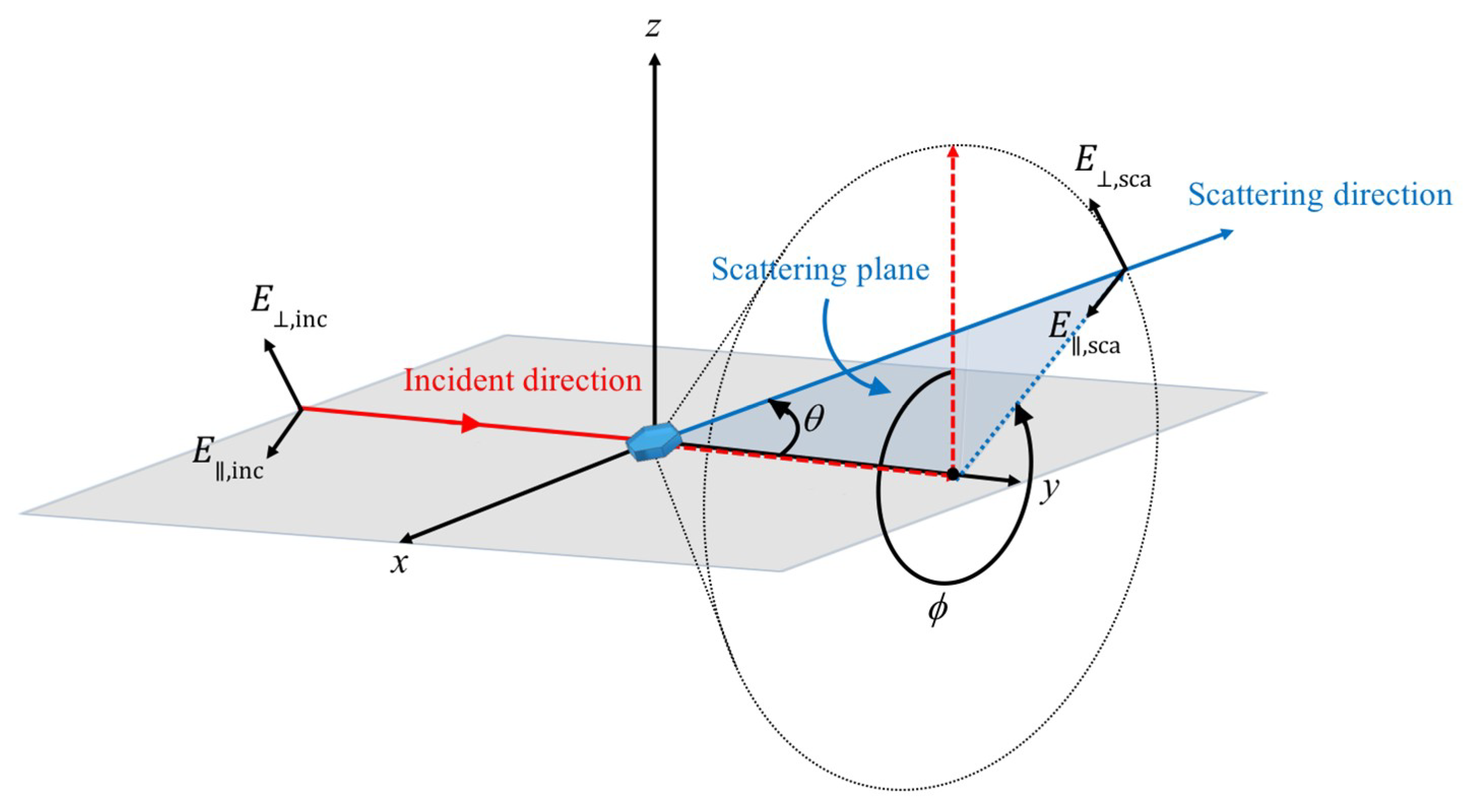
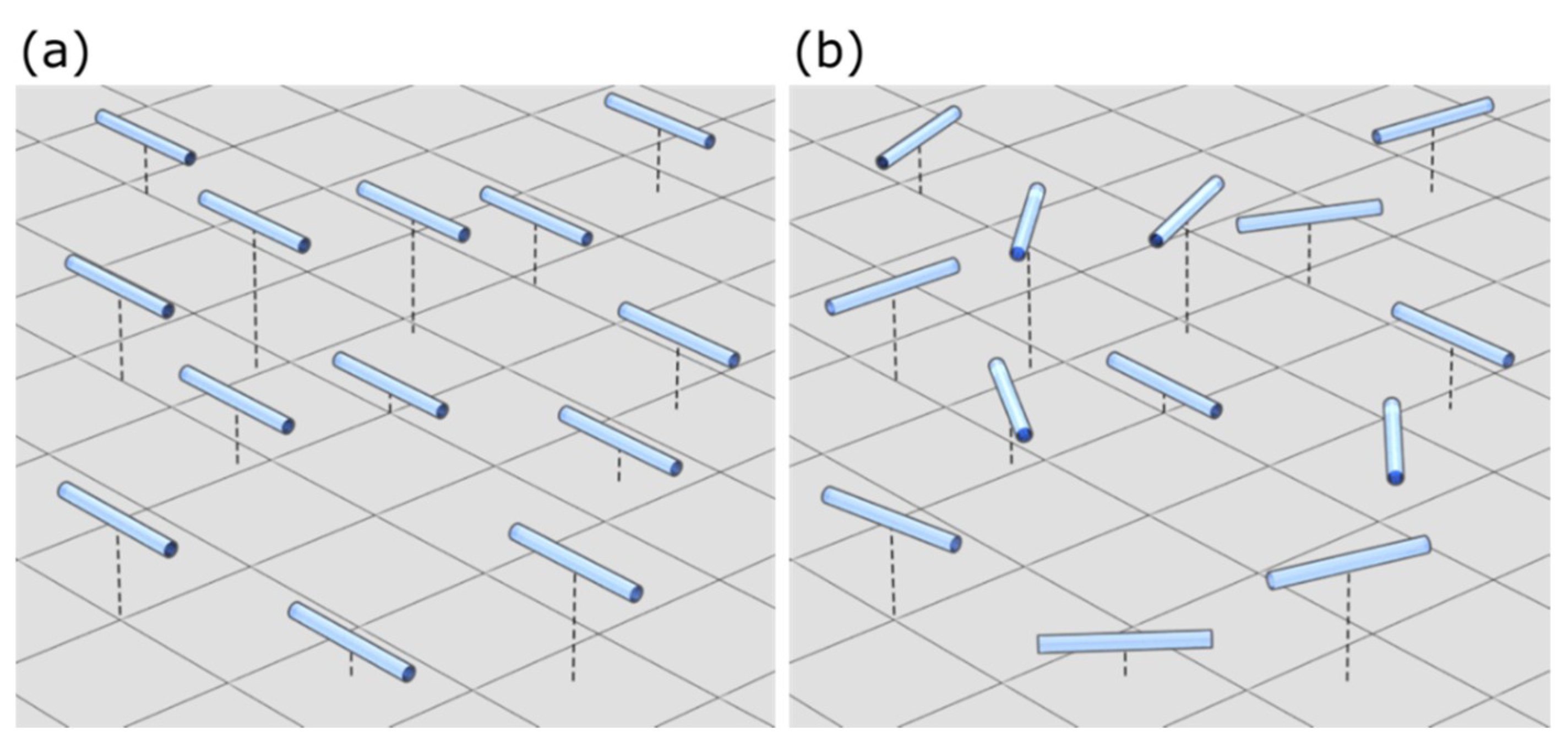
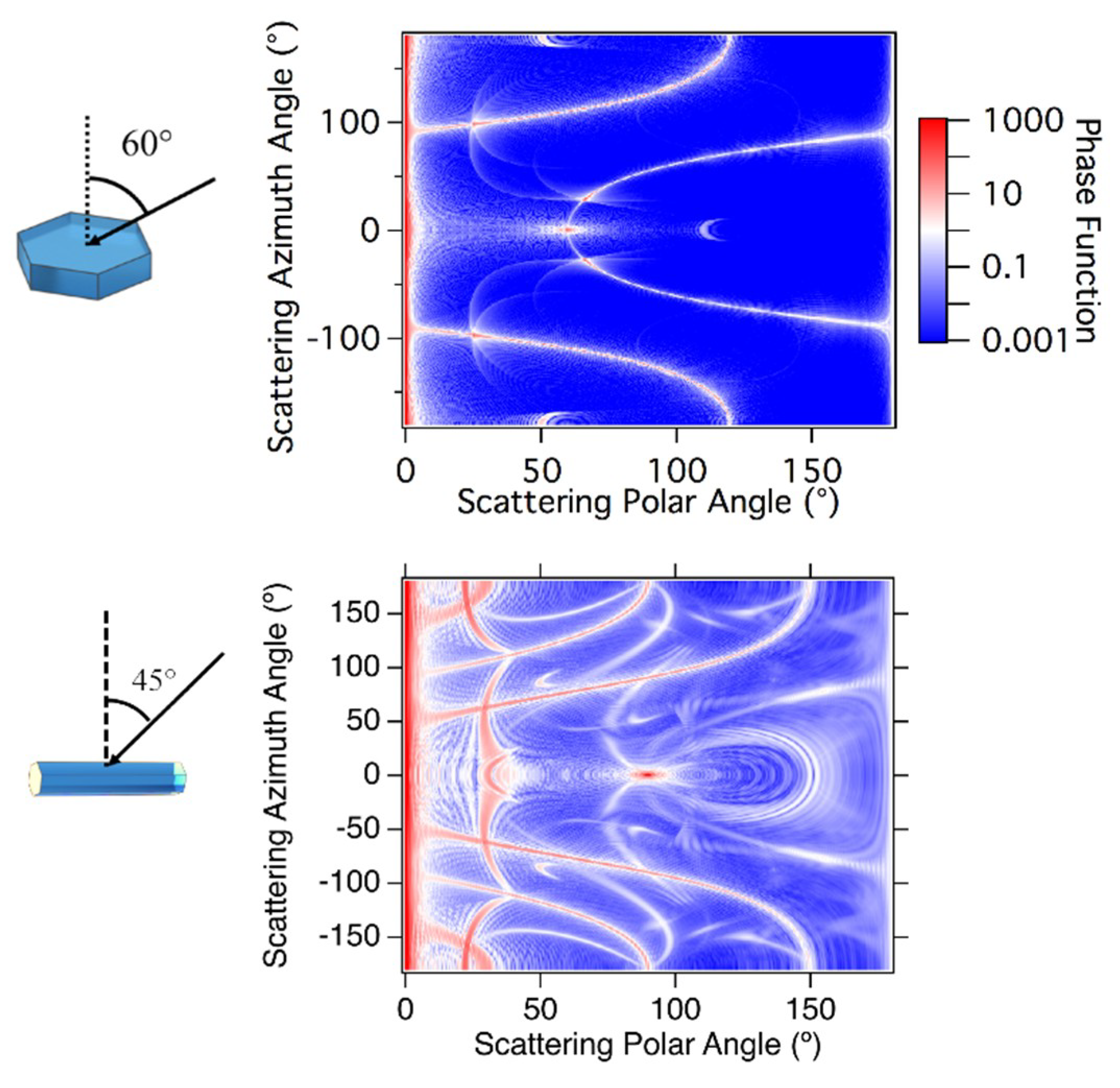
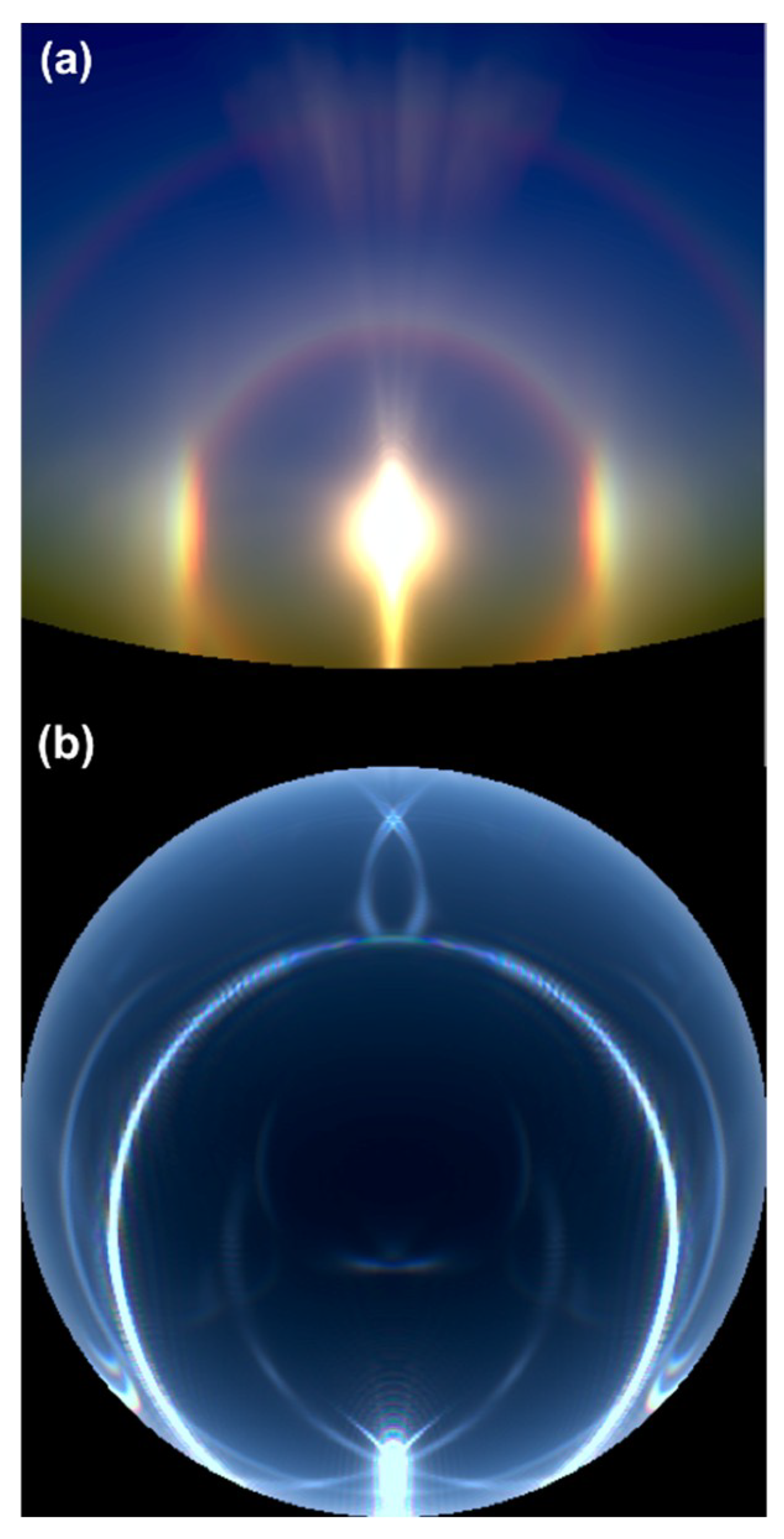

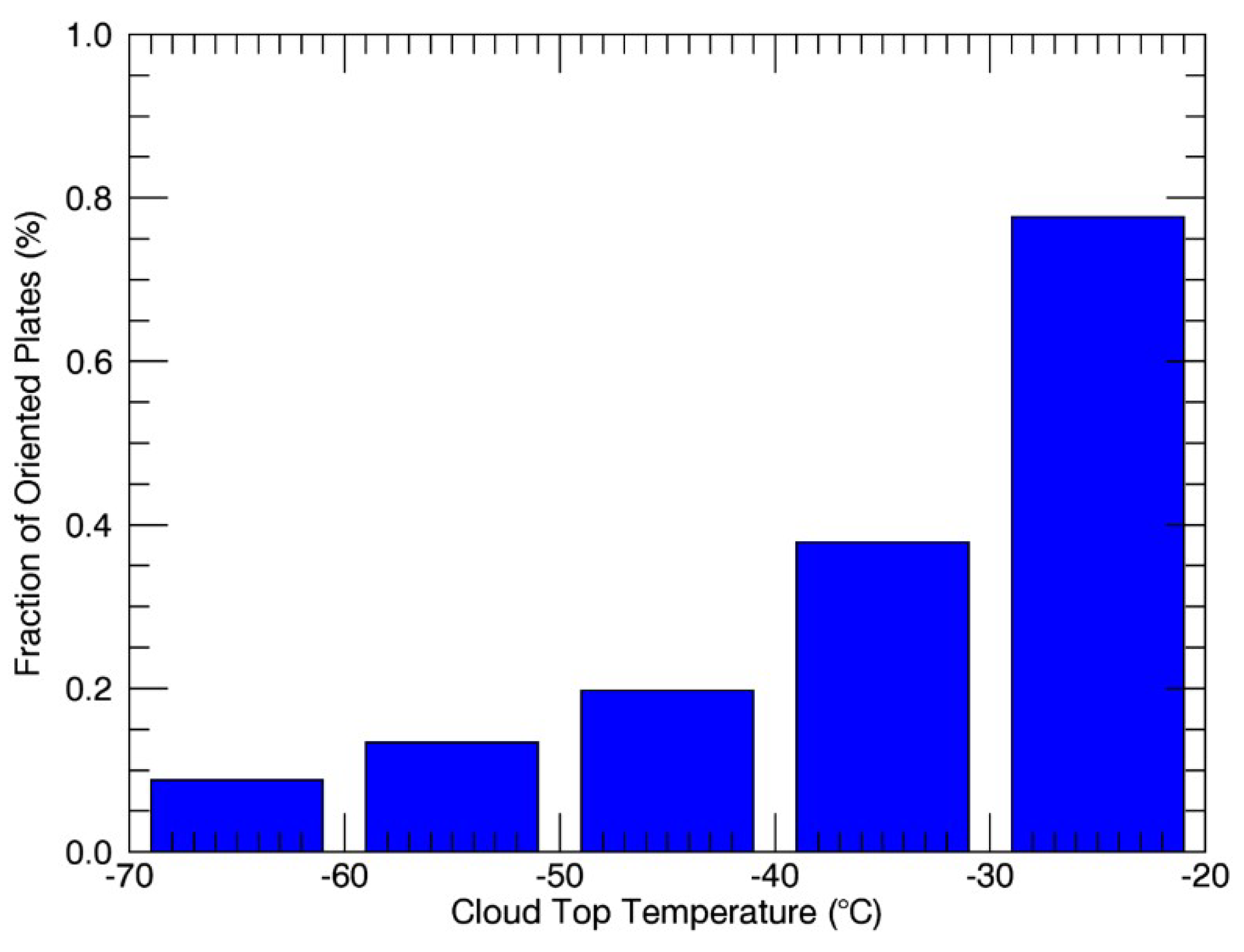
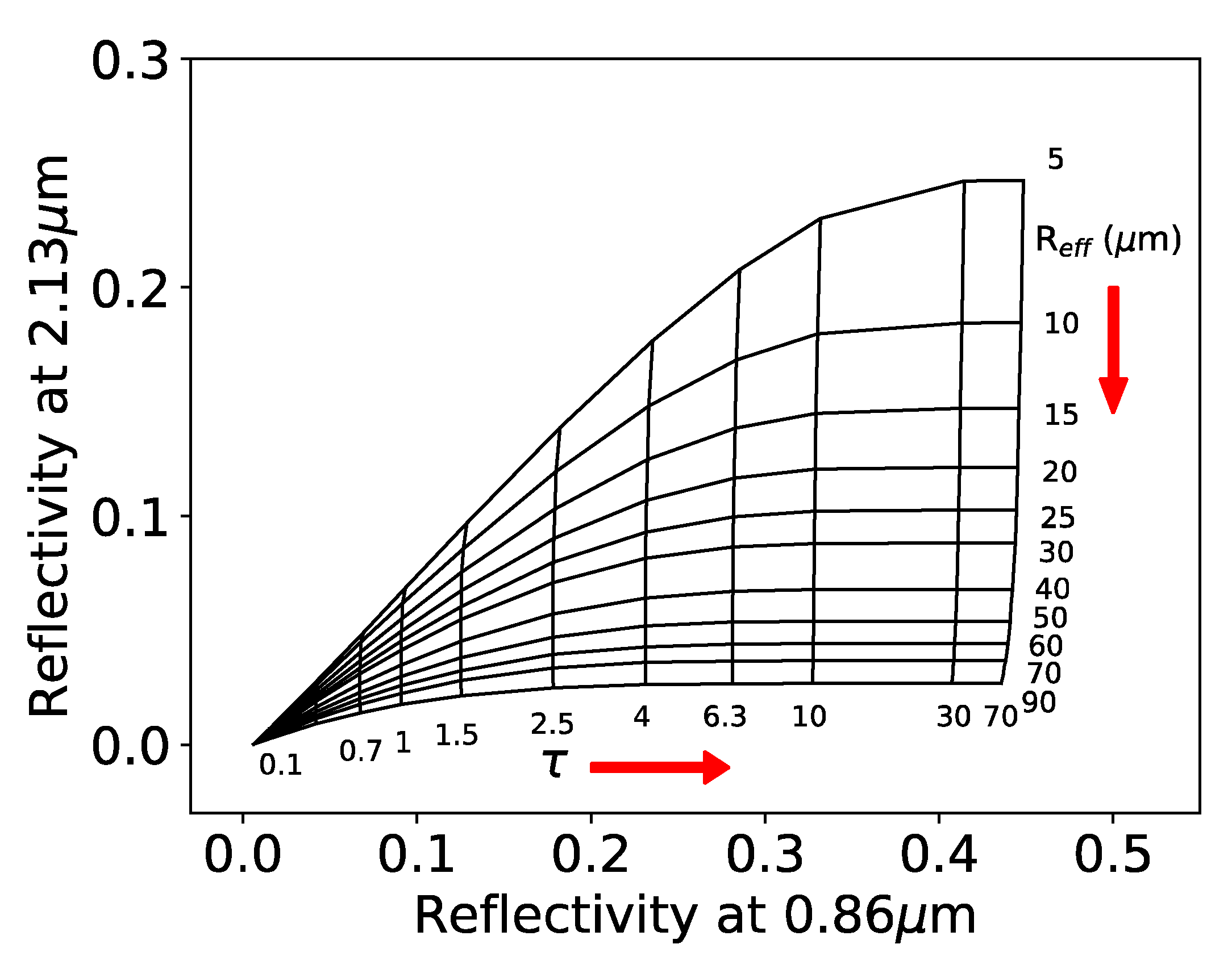
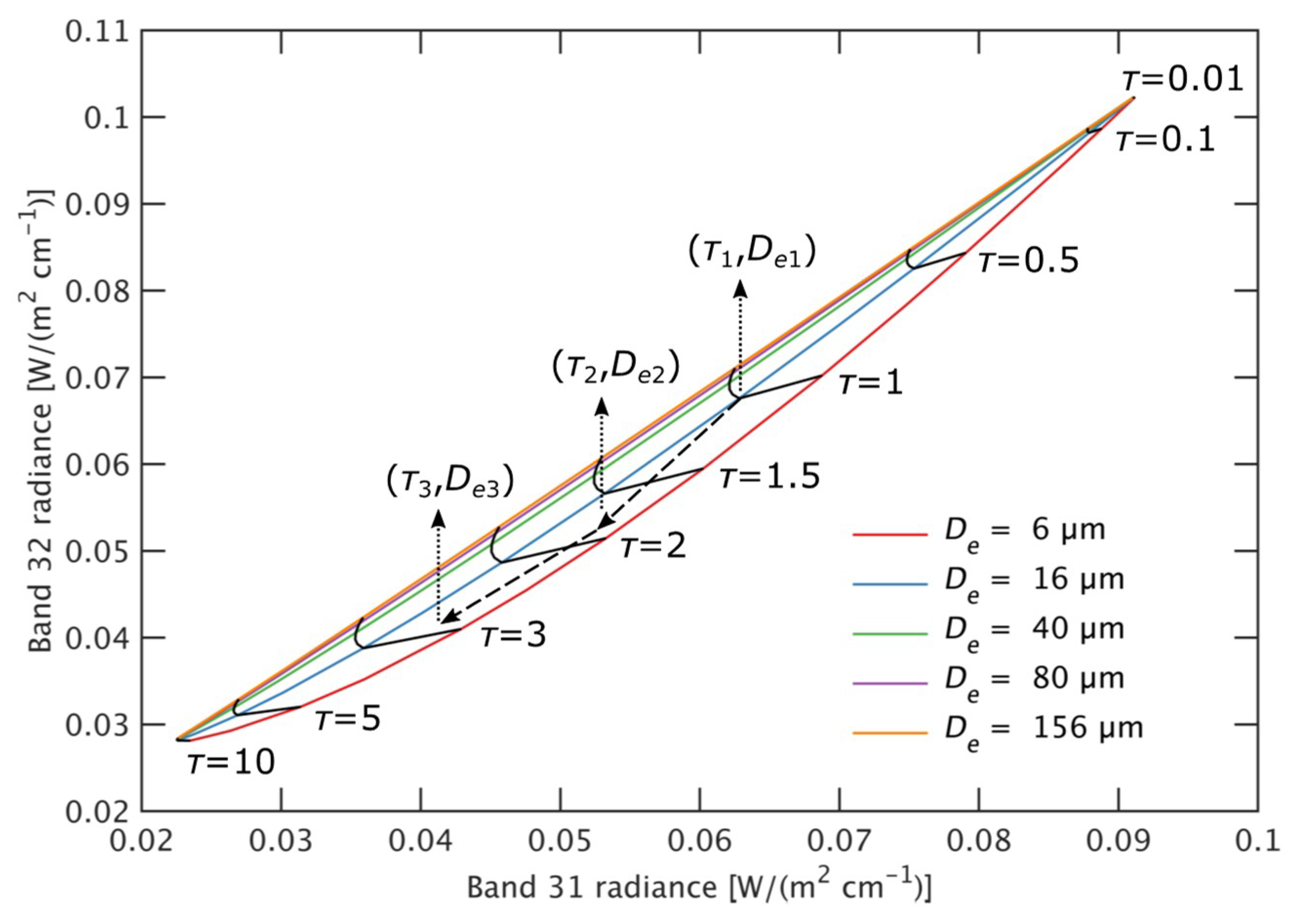
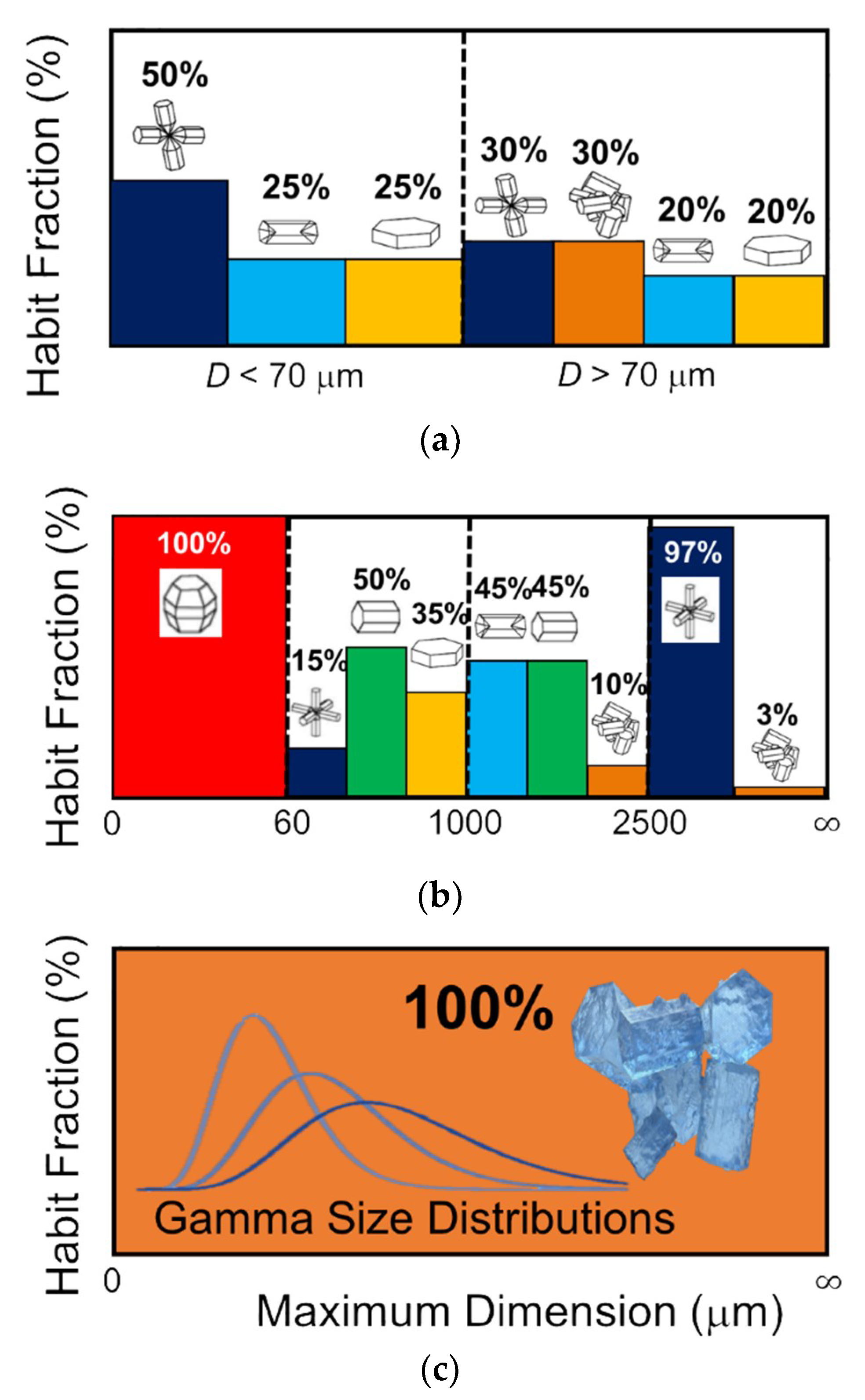

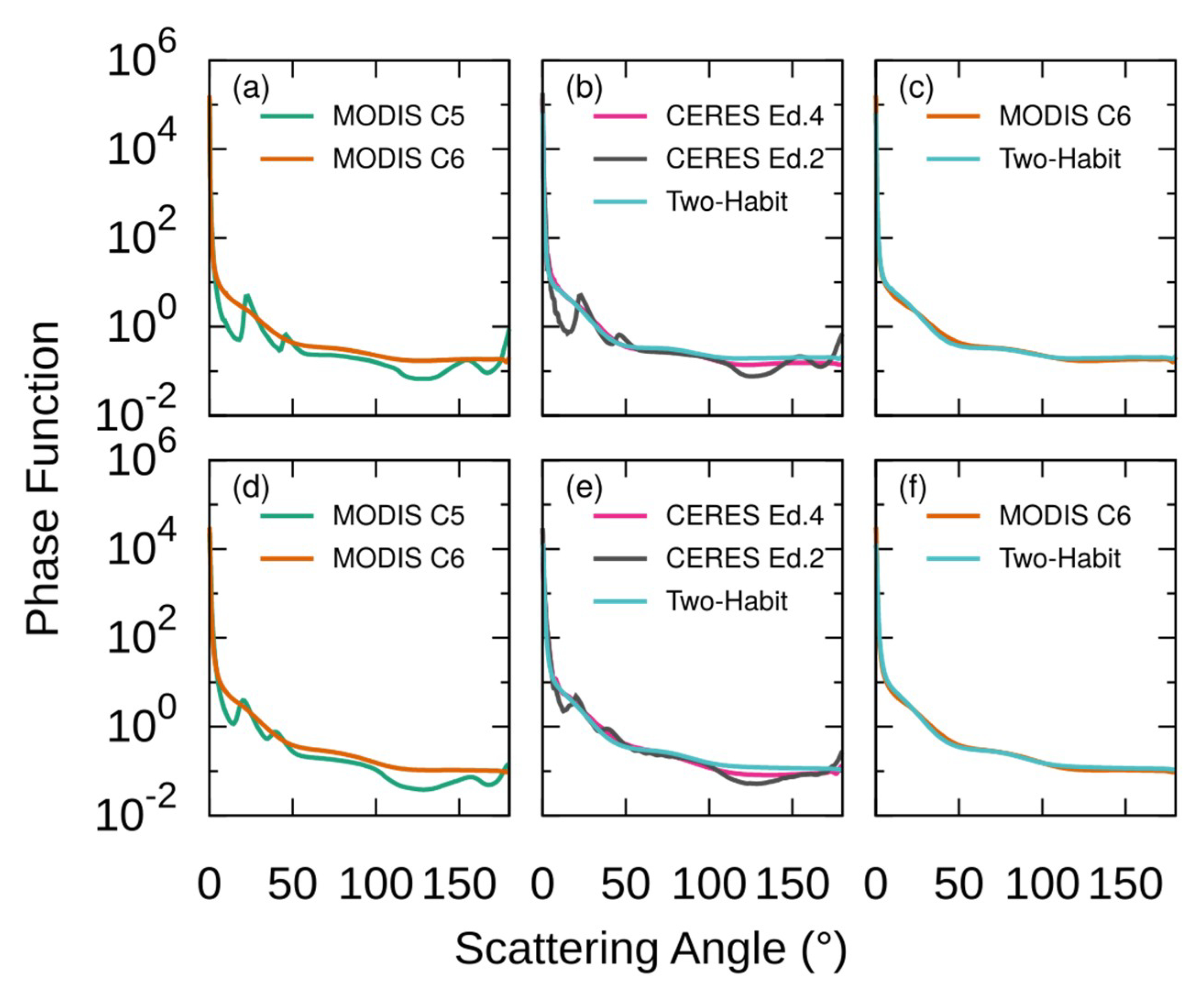
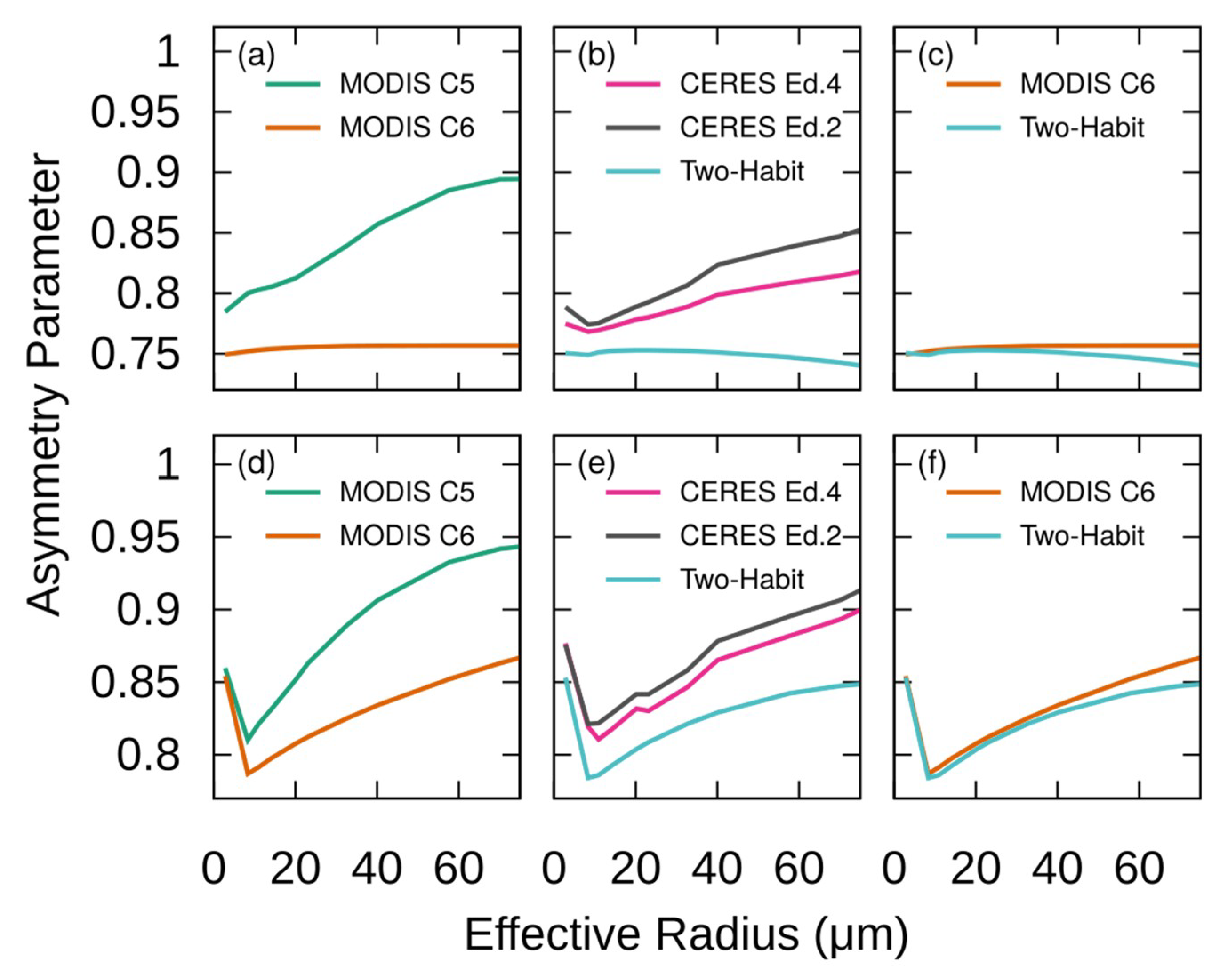
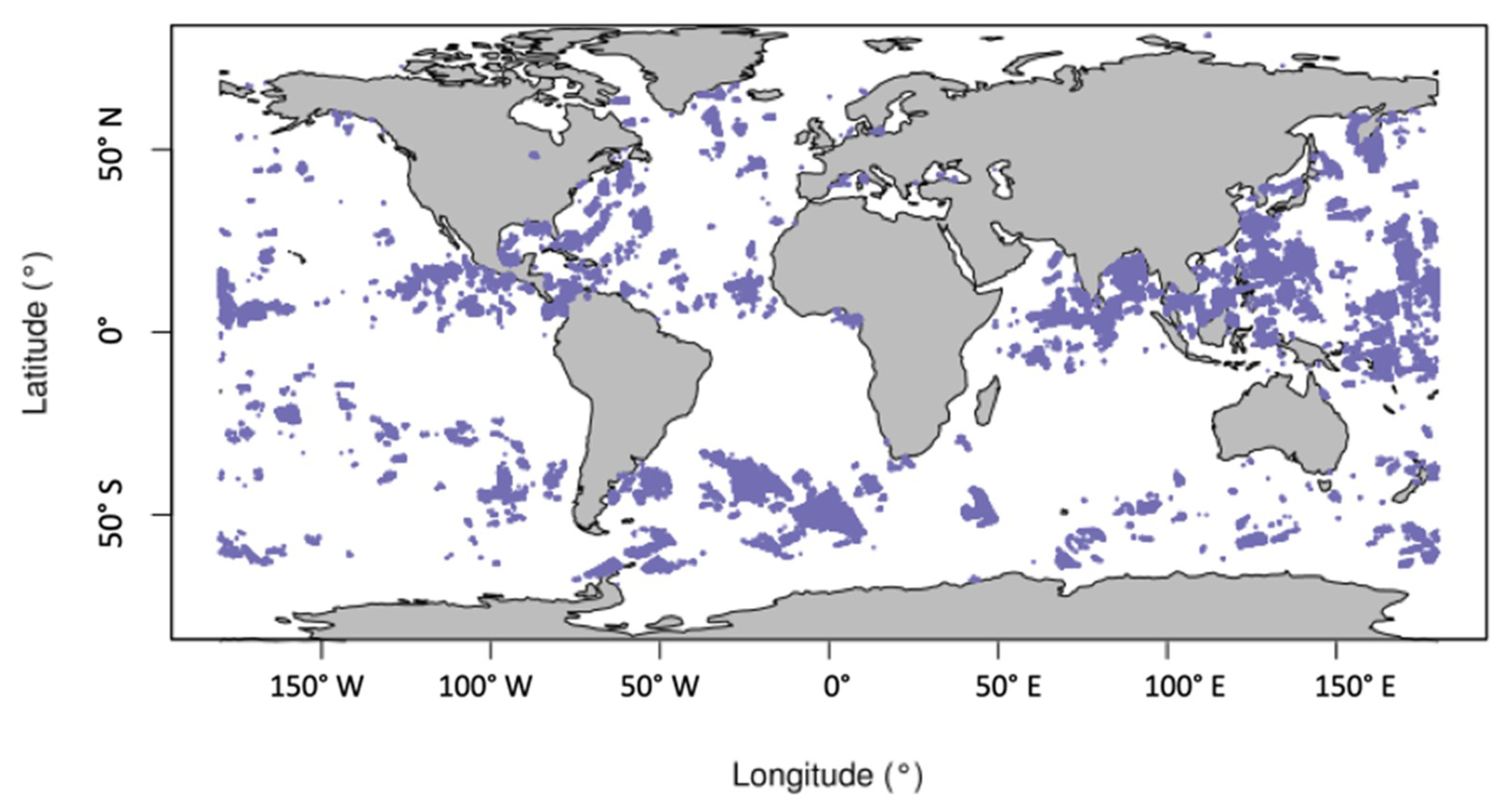
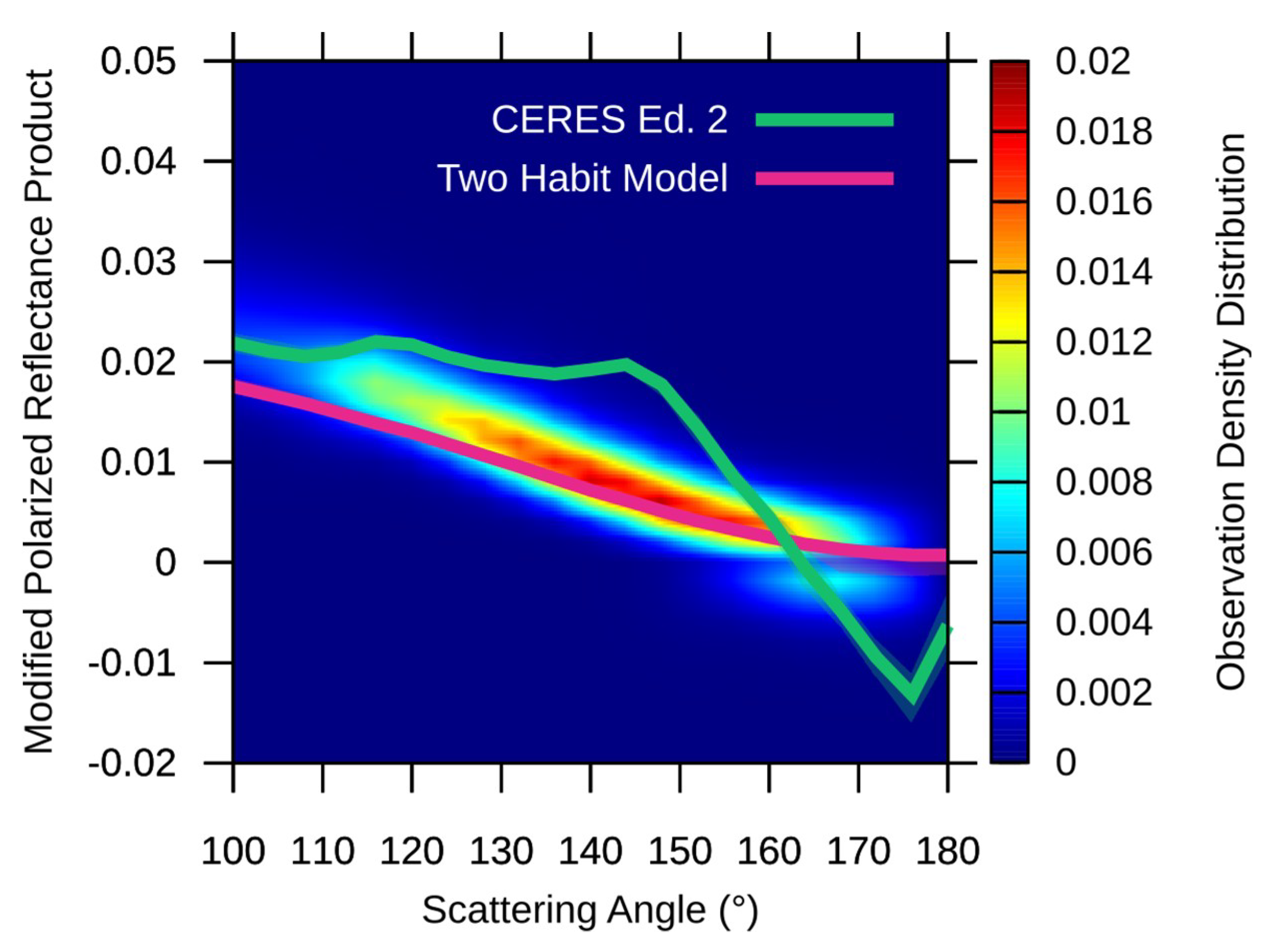
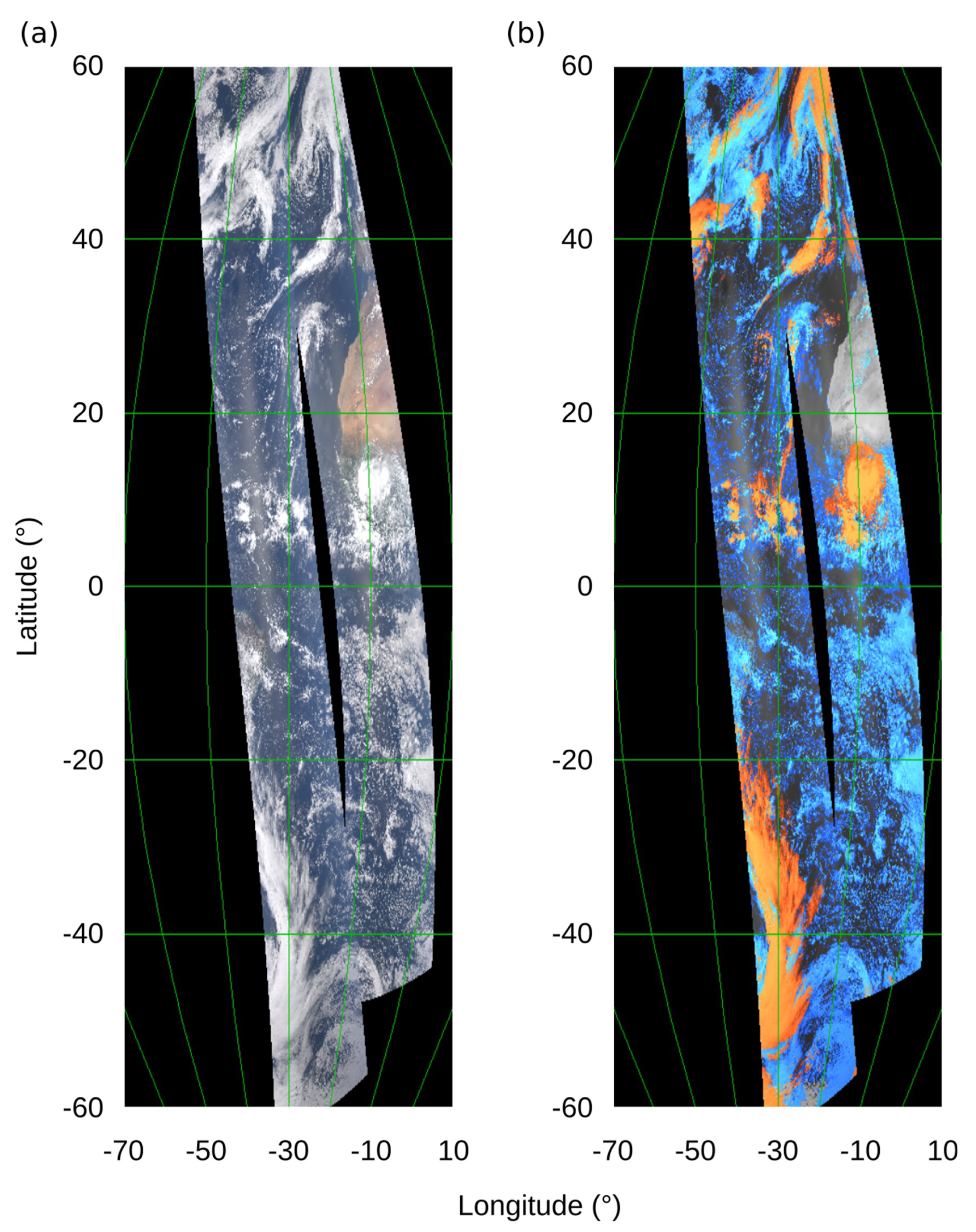
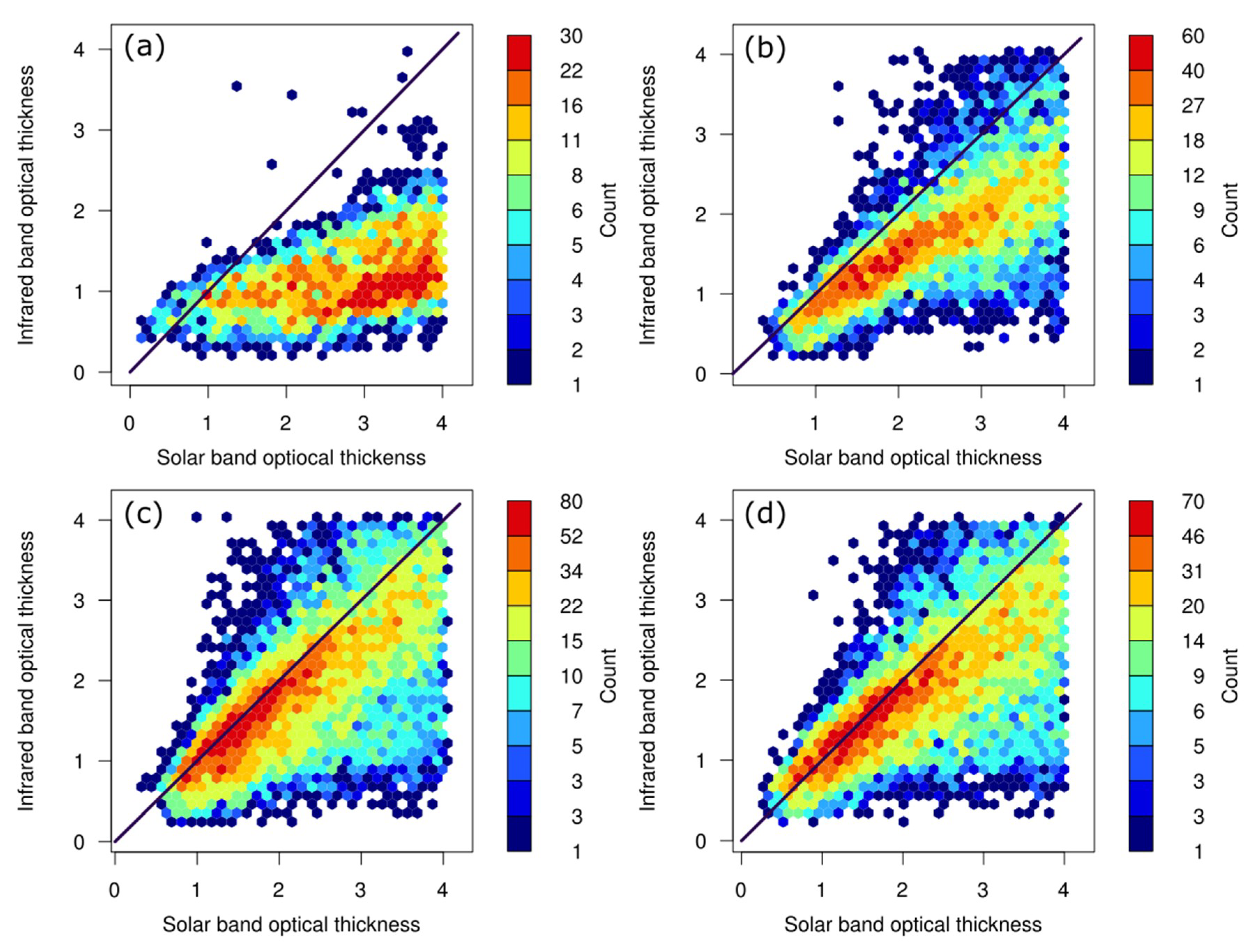
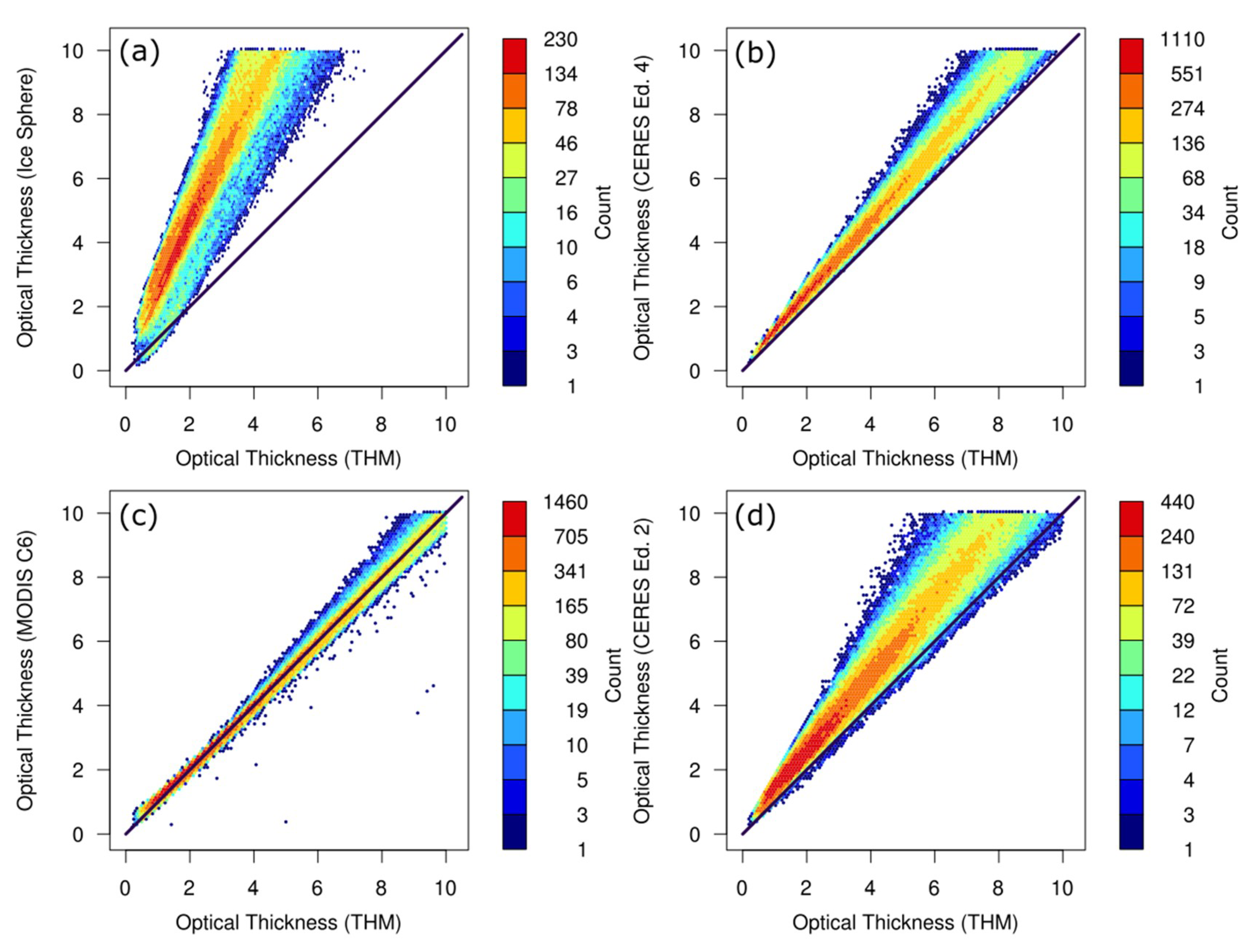
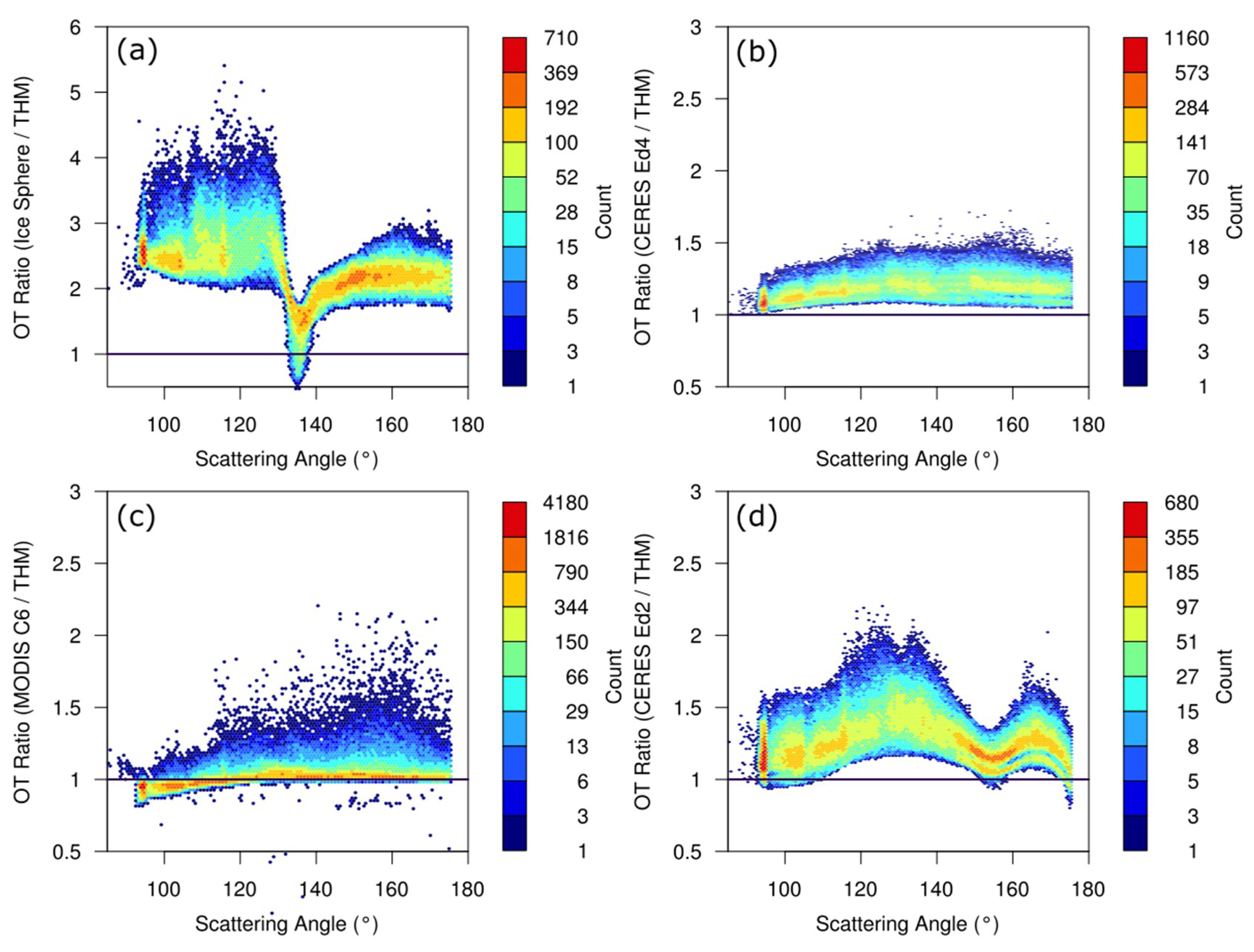
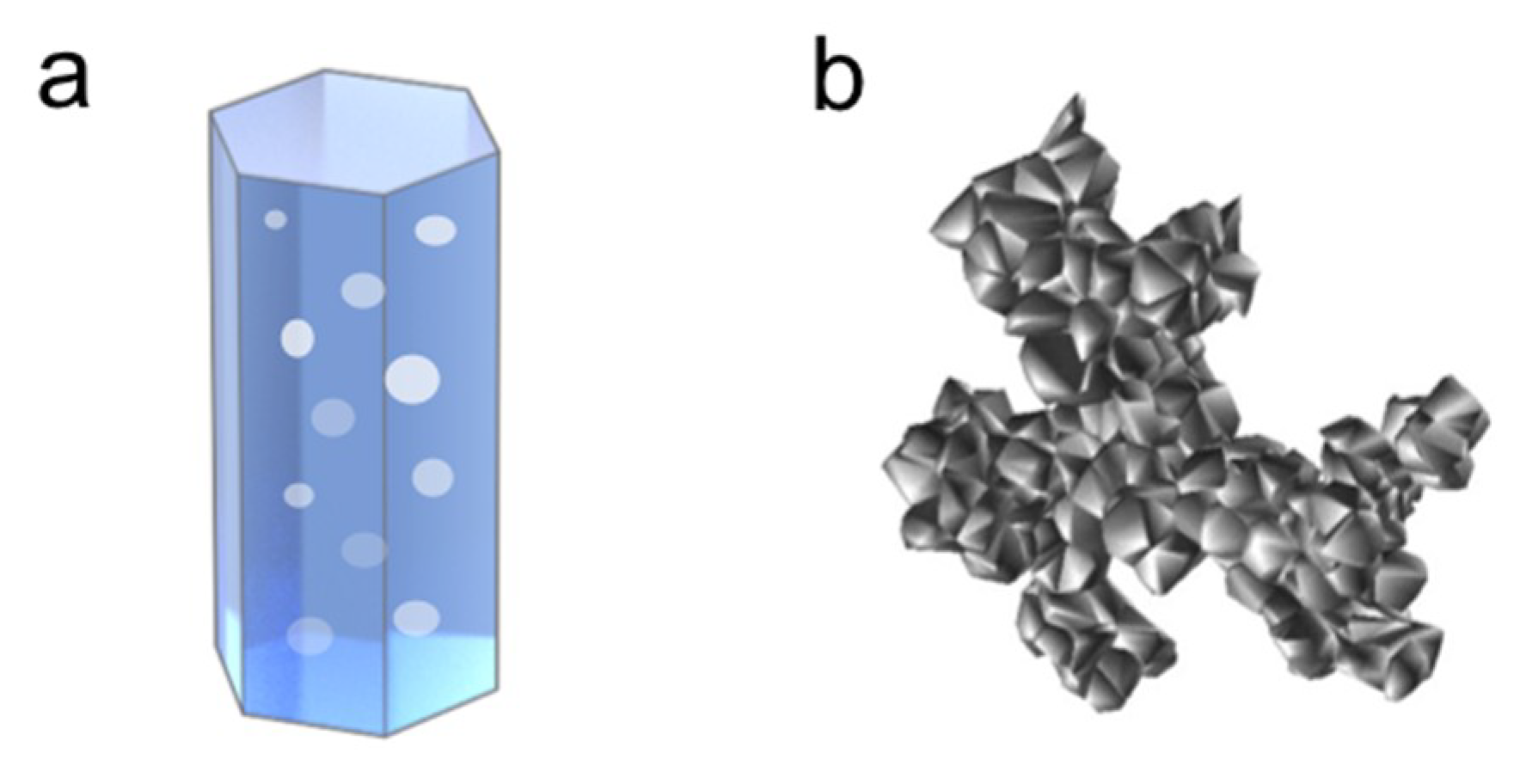
© 2018 by the authors. Licensee MDPI, Basel, Switzerland. This article is an open access article distributed under the terms and conditions of the Creative Commons Attribution (CC BY) license (http://creativecommons.org/licenses/by/4.0/).
Share and Cite
Yang, P.; Hioki, S.; Saito, M.; Kuo, C.-P.; Baum, B.A.; Liou, K.-N. A Review of Ice Cloud Optical Property Models for Passive Satellite Remote Sensing. Atmosphere 2018, 9, 499. https://doi.org/10.3390/atmos9120499
Yang P, Hioki S, Saito M, Kuo C-P, Baum BA, Liou K-N. A Review of Ice Cloud Optical Property Models for Passive Satellite Remote Sensing. Atmosphere. 2018; 9(12):499. https://doi.org/10.3390/atmos9120499
Chicago/Turabian StyleYang, Ping, Souichiro Hioki, Masanori Saito, Chia-Pang Kuo, Bryan A. Baum, and Kuo-Nan Liou. 2018. "A Review of Ice Cloud Optical Property Models for Passive Satellite Remote Sensing" Atmosphere 9, no. 12: 499. https://doi.org/10.3390/atmos9120499
APA StyleYang, P., Hioki, S., Saito, M., Kuo, C.-P., Baum, B. A., & Liou, K.-N. (2018). A Review of Ice Cloud Optical Property Models for Passive Satellite Remote Sensing. Atmosphere, 9(12), 499. https://doi.org/10.3390/atmos9120499





